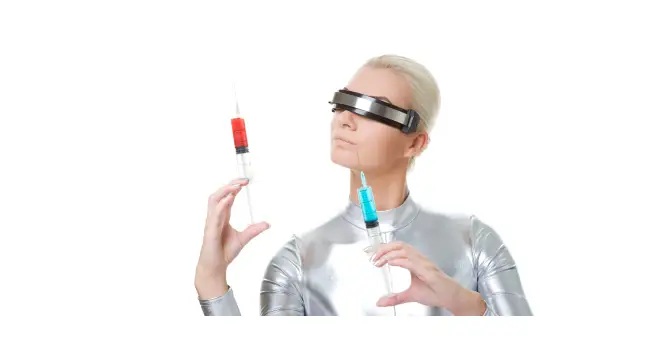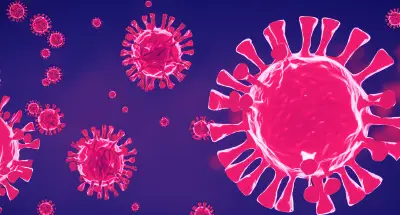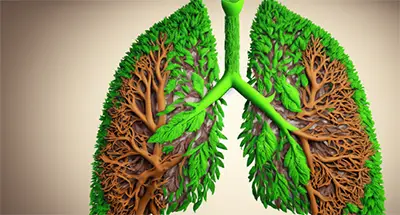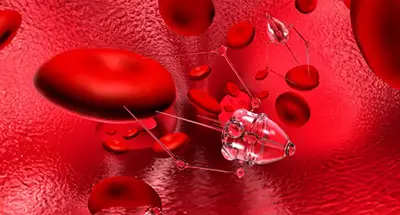Future Medical Technology

Future medical technology breakthroughs will build from the incredible progress made in nanotechnology, biotechnology, computers, the information learned from deciphering the human genome and other scientific and technical areas.
Here are some of the futuristic medical devices and technologies that exist, are in development or are predicted.
- Brain-computer interface
- Care giving robots
- Computer aided diagnosis
- Drug delivery devices
- Regenerative medicine, replacement organs
- Emotional/physical control devices
- Slowing or stopping aging
- Drug delivery devices
- Gene therapy/manipulation
- Home/self monitoring & diagnosis
- Minimally invasive procedures
- Molecular and genetic diagnostics
- Neural Stimulation
- Organ replacement / growing organs
- Personalized drugs
- Robotic surgery
- Bioengineered devices
- Virtual medicine
- Extended/eternal life
- Synthetic life
- Repairing/manipulating DNA
- Organ replacement / growing organs
- Designer babies / designer bodies
- Personalized drugs
- Gene therapy/manipulation
- Biostasis - Cryogenic sleep
- Human cloning
- Virtual/robot medicine
- Instant pain relief
- Biosensors - implanted or in clothing
- Bionic implants to allow for extreme strength
- Morphing of the human body
- Age reversal
- Creation of organisms
- Synthetic organs
- Enhanced senses
- Alteration of our bodies in superhuman ways
- Bionic limbs
- Use genes of other animals to implant in us
- Artificial immune system
- A capsule that can be swallowed which will cure all diseases
Forever Young

In 2019, global life expectancy was 73.4 years, up from 66.8 years in 2000. But, some futurists believe that a child born today might actually live forever.
Babies Growing Outside the Womb

Artificial wombs are mechanisms that are used to grow an embryo outside of the body of a female. Could this be the future of reproduction for humans? Scientists have grown mice embryos in man-made, bubble shaped wombs.
Health Watch

The house call is back. Doctors can already gather your glucose from their gardens and check your liver from the links (though your butt may come after the putt). Remote medical monitoring will be commonplace in the future and it promises to benefit both physicians and patients by saving time and money.
Pandemic Research

Influenza viruses are classified as type A, B, or C based upon their protein composition. Type A viruses are found in many kinds of animals, including ducks, chickens, pigs, whales, and also in humans.
The type B virus widely circulates in humans. Type C has been found in humans, pigs, and dogs and causes mild respiratory infections, but does not spark epidemics. Type A influenza is the most frightening of the three. It is believed responsible for the global outbreaks of 1918, 1957 and 1968. COVID was declared a pandemic by the World Health Organization in March 2020.
Can technology protect us from the COVID and the flu?
Regenerative Medicine

Imagine a world where there is no donor organ shortage. Where victims of spinal cord injuries can walk, where weakened hearts are replaced. This is the long-term promise of regenerative medicine, a rapidly developing field with the potential to transform the treatment of human disease through the development of innovative new therapies that offer a faster, more complete recovery with significantly fewer side effects or risk of complications.
Nanomedicine

Nanomedicine is promising great things, including great advancements in the treatment of cancer. Imagine swarms of nanobots swimming through your veins, repairing cells or attacking viruses. On second thought, get that image out of your mind, it's a bit creepy. Just close your eyes and wait for the healing to begin.
Future of Medicine Articles and Web Sites
I search the internet daily for new articles from around the world that interest me or I think will interest you. My hope is that it saves you time or helps students with their assignments. Listed by most recent first, dating back to 2005.
-
Pig organs in people: The future of cross-species transplants from Knowable Magazine
-
Scientists Say They’ve Discovered How Cancer Hijacks and Corrupts Immune Cells from Singularity Hub
-
Visualizing a Key Step in How an NRPS Enzyme Produces an Antibiotic from UC San Diego
-
New bioprinting technique creates functional tissue 10x faster from Penn State
-
Breakthrough Autism Study Unveils New Mechanisms and Promising Genetic Treatment from SciTechDaily
-
Gene editing technology is revolutionizing disease treatment video
-
Study discovers what’s behind heart cell damage from chemotherapy from Stanford Medicine
-
World-first stem-cell treatment restores vision in people from Nature
-
Potential drugs for cancer treatment may help tackle tuberculosis from Cornell Chronical
-
Researchers engineer experimental drug for preventing heart failure after heart attacks from UCLA
-
Are Biologics the Future of Food Allergy Treatment? One Study Weighs Pros and Cons from UNC
-
Autoimmune Diseases Stopped in Their Tracks by ‘Phenomenal’ Donor Cell Therapy from Singularity Hub
-
In Medical First, Woman’s Type 1 Diabetes Seemingly Cured by Stem Cells from Gizmodo
-
Moderna’s ‘Off-the-Shelf’ Cancer Vaccine Shows Promise in Early Human Trial Data from Gizmodo
-
A New Gene Therapy Reprograms Cancer Cells to Fight Themselves from Singularity Hub
-
Alzheimer’s Breakthrough: New Drug Shows Promise in Reversing Memory Loss and Cognitive Decline from SciTechDaily
-
Alzheimer’s Imaging Breakthrough: Fluorescent Sensors Penetrate Blood-Brain Barrier from SciTechDaily
-
Dual-action antibiotic could make bacterial resistance nearly impossible from UIC Today
-
How 3D Printing Could Revolutionize The Way You Get Your Medication from Slash Gear
-
Harnessing Nutrients: Scientists Discover New Way To Effectively Treat Cancer from SciTechDaily
-
mRNA Cancer Vaccines Spark Renewed Hope as Clinical Trials Gain Momentum from Singularity Hub
-
From Wearables to Swallowables: USC Engineering Researchers Create GPS-like Smart Pills with AI from USC Viterbi
-
World-first tooth-regrowing drug will be given to humans in September from New Atlas
-
Root canal? Next-gen treatment could involve stem cells, not surgery from University of Buffalo
-
Experimental gene therapy restores some vision in patients with inherited blindness from CNN
-
Personalised and precise: Meet the researchers driving the radiopharmaceutical revolution from The University of Queensland
-
‘Real hope’ for cancer cure as personal mRNA vaccine for melanoma trialled from The Guardian
-
Pacemaker powered by light eliminates need for batteries and allows the heart to function more naturally − new research from The Conversation
-
Ambient artificial intelligence technology to assist Stanford Medicine clinicians with taking notes from Stanford Medicine
-
High-tech 'paint' could spare patients repeated surgeries from EurekAlert
-
3D-printed skin closes wounds and contains hair follicle precursors from EurekAlert
-
Discovery of ‘molecular machine’ brings new immune therapies a step closer from Yale News
-
Scientists Are Finally Cracking The Code For 3D Printed Eyes from Inverse
-
ChatGPT in medical education: Generative AI and the future of artificial intelligence in health care from AMA
-
Team develops prototype for 4D printed medical implant that promotes regeneration of soft tissue from Mizzou Engineering
-
Handing the surgeon’s scalpel to a robot from Knowable Magazine
-
Researchers use 3D ice printing to create artificial blood vessels for organ transplants from ZME Science
-
From smart knees to artificial hearts: The future of medical implants from ABC Action News
-
Gene therapy hailed as ‘medical magic wand’ for hereditary swelling disorder from The Guardian
-
Artificial intelligence is revolutionizing medical research from Arizona State University
-
New ultrasound tech could be used to 3D-print implants inside the body from New Atlas
-
A breakthrough in research on a fatal disease from EurekAlert
-
A new machine is able to keep the brain alive without a heart from Freethink
-
Scientists 3D-print hair follicles in lab-grown skin from ScienceDaily
-
Gold-laced gel could help you recover from a major muscle injury from Freethink
-
Scientists Create 'Super Melanin' That Speeds Healing, Stops Sunburn, and More from Gizmodo
-
Millionaire uses Artificial Intelligence to develop medicine from BBC
-
Eye implant may be used to treat diabetes from EurekAlert
-
SpeakerBeam hearing aid tech only amplifies specific people's voices from New Atlas
-
Stanford plans to put a 3D-printed human heart in a pig by 2028 from Freethink
-
Scientists Print Skin That's More Human-Like Than Anything Before It from Gizmodo
-
London robotic surgeon celebrates its 10,000th procedure from BBC
-
How unique immune cells can recognize—and destroy—tumors from EurekAlert
-
A pig kidney is still working in a person after 32 days from Freethink
-
A journey into the human body: How VR helps me understand my injury and heal from Mixed Reality News
-
Researchers Engineer Bacteria That Can Detect Tumor DNA from UC San Diego
-
Single-Shot Gene Therapy Aims to Cure Blood Disorders Like Sickle Cell from Singularity Hub
-
‘Living Drug’ CAR T Is Taking on Some of Humanity’s Worst Medical Scourges from Singularity Hub
-
First successful robotic liver transplant performed in the US from New Atlas
-
The Electrome: The Next Great Frontier For Biomedical Technology from IEEE Spectrum
-
Cancer breakthrough uses CRISPR to target extra chromosomes from New Atlas
-
Full-Body AI Scans Could Be the Future of Preventive Medicine from CNET
-
In a First, an AI-Designed Drug Is Being Tested in Humans to See if It Actually Works from Singularity Hub
-
Baldness Breakthrough: microRNA Stimulates Hair Growth in Aging Follicles from SciTechDaily
-
Machine learning meets nanotechnology, award-winning implant regulates blood pressure from Physics World
-
Will artificial intelligence help — or hurt — medicine? from NPR
-
The US DOD has invented a wearable that quickly identifies infections from Interesting Engineering
-
This Amazing Molecular Syringe Could Smuggle Drugs and Gene Therapies Into Human Cells from Singularity hub
-
A New Treatment for Lung Infections: Scientists Have Created a Unique Living Medicine from SciTechDaily
-
Doctor Apple Wants to Scan Your Entire Body Now from Gizmodo
-
Stanford Medicine scientists transform cancer cells into weapons against cancer from Stanford University
-
Nanosatellite shows the way to RNA medicine of the future from EurekAlert
-
German man third to be completely cured of HIV after stem cell transplant from New Atlas
-
Rice scientists reengineer cancer drugs to be more versatile from Rice University
-
New cyborg cells could be the future of medicine from Freethink
-
Researchers Have Created A Cellular ‘Glue’ That Can Regenerate Tissues, Heal Wounds, And Regrow Nerves from Wonderful Engineering
-
Cellular 'glue' to regenerate tissues, heal wounds, regrow nerves from EurekAlert
-
'Heart attack on a chip’ could unlock new cardiac treatments from BBC Science Focus
-
The future of sleep from Inverse
-
Smart bandage to speed healing time of chronic wounds by 25 per cent from Telangana Today
-
First of Its Kind Gene Therapy Treatment Approved for Hemophilia from Gizmodo
-
Scientists uncovered the structure of the key protein for a future hepatitis C vaccine – here’s how they did it from The Conversation
-
In a World First, Two People Received Transfusions of Lab-Grown Blood from Singularity Hub
-
A blood test that screens for multiple cancers at once promises to boost early detection from The Conversation
-
A modified herpes virus completely wiped out a terminal cancer from Freethink
-
This AI Uses a Scan of Your Retina to Predict Your Risk of Heart Disease from Singularity Hub
-
The Human Immunome Project is the Next Big Leap from NEO.LIFE
-
Scientists convert kidney to universal type O blood from Big Think
-
Single-Dose Polypill Found to Save Lives, Prevent Heart Attacks in Major New Trial from Gizmodo
-
Pig to human heart transplants are the future. Are we ready for it? from The Guardian
-
How Scientists Revived Organs in Pigs an Hour After They Died from Singularity Hub
-
Eye implant made from pig skin reverses blindness in 14 people from Freethink
-
A dog cancer vaccine may save them and, one day, us from Freethink
-
Pressure mounts on FDA to expand pig-to-human organ transplant research from Engadget
-
CRISPR cure for sickle cell nearly 100% effective after three years from Freethink

